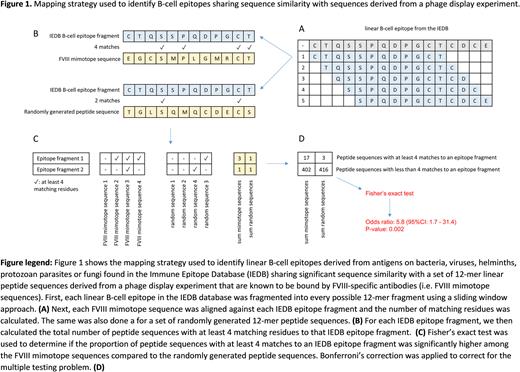Abstract
Introduction Inhibitor development is the most severe complication of hemophilia A care. Previous exposure to a foreign pathogen may elicit an adaptive immune response during later exposure to FVIII due to sequence similarity between antigens present in the organism and factor VIII (FVIII).
Aim The aim of this study was to use a novel epitope mapping method to assess if FVIII-specific B-cell epitopes share sequence similarity with linear B-cell epitopes from pathogens that were previously deposited in the Immune Epitope Database (IEDB).
Methods The population consisted of 122 patients with severe hemophilia A that were followed-up for 50 days of exposure to FVIII. Thirty-nine patients were inhibitor-positive and 83 were inhibitor-negative. The FVIII-specific B-cell epitope repertoire of this cohort was assessed by means of a random peptide phage-display library assay, in both samples taken before exposure to FVIII (pre-exposure samples) and samples taken after exposure to FVIII (post-exposure samples). The assay generated a set of 12-mer linear peptide sequences that are known to be bound by FVIII-specific antibodies (i.e. FVIII mimotopes). We then screened these FVIII mimotope sequences against a set of linear B-cell epitopes derived from antigens on bacteria, viruses, helminths, protozoan parasites or fungi found in the Immune Epitope Database (IEDB), using a custom screening method. (Figure 1) The degree to which FVIII mimotope sequences with good alignment to the top-scoring linear B-cell epitopes in the IEDB database could predict inhibitor development was evaluated using the C-statistic.
Results The assay and analysis pipeline were applied to the pre-exposure samples. The most common pathogens from which the top 10 linear B-cell epitopes were derived were human betaherpesvirus 6B (3x), human alphaherpesvirus 2, mycobacterium tuberculosis (2x), trypanosoma cruzi, hepatitis delta virus, human immunodeficiency virus 1 and dengue virus 3. The predictive value of 19 FVIII mimotope sequences with good alignment to the top-scoring linear B-cell epitopes derived from the IEDB database, measured using the C-statistic, varied from 0.5 to 0.52. The C-statistic of a penalized logistic regression model containing all 19 FVIII mimotope sequences as variables was 0.63 (95%CI: 0.52-0.74) when these variables were measured in pre-exposure samples and 0.62 (95%CI: 0.5-0.73) when measured in post-exposure samples.
Conclusion Using a custom screening approach, we have identified a group of pathogens that share some sequence similarity with a set of FVIII mimotope sequences obtained from a novel random peptide phage-display library assay. The predictive value of these FVIII mimotope sequences for inhibitor development was moderate.
Disclosures
Peyvandi:Sanofi: Membership on an entity's Board of Directors or advisory committees; Sobi: Membership on an entity's Board of Directors or advisory committees; Takeda: Membership on an entity's Board of Directors or advisory committees; Roche: Membership on an entity's Board of Directors or advisory committees, Other: educational meeting; Biomarin: Membership on an entity's Board of Directors or advisory committees; Grifols: Other: educational meeting.
Author notes
Asterisk with author names denotes non-ASH members.


This feature is available to Subscribers Only
Sign In or Create an Account Close Modal